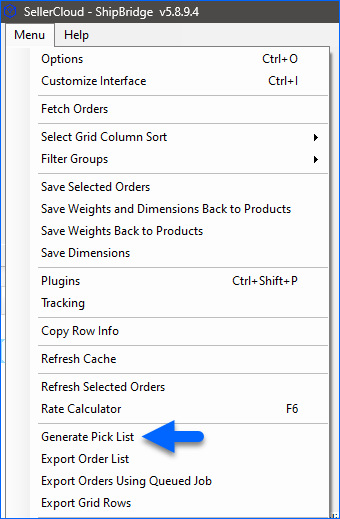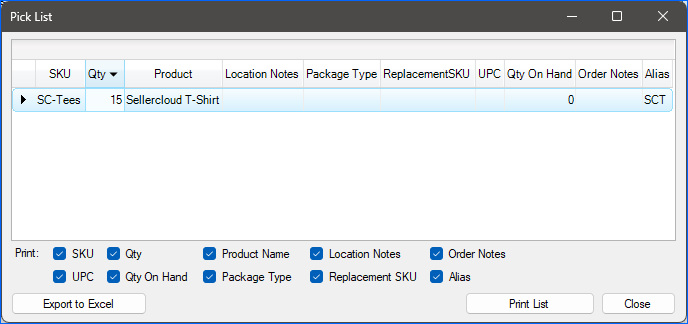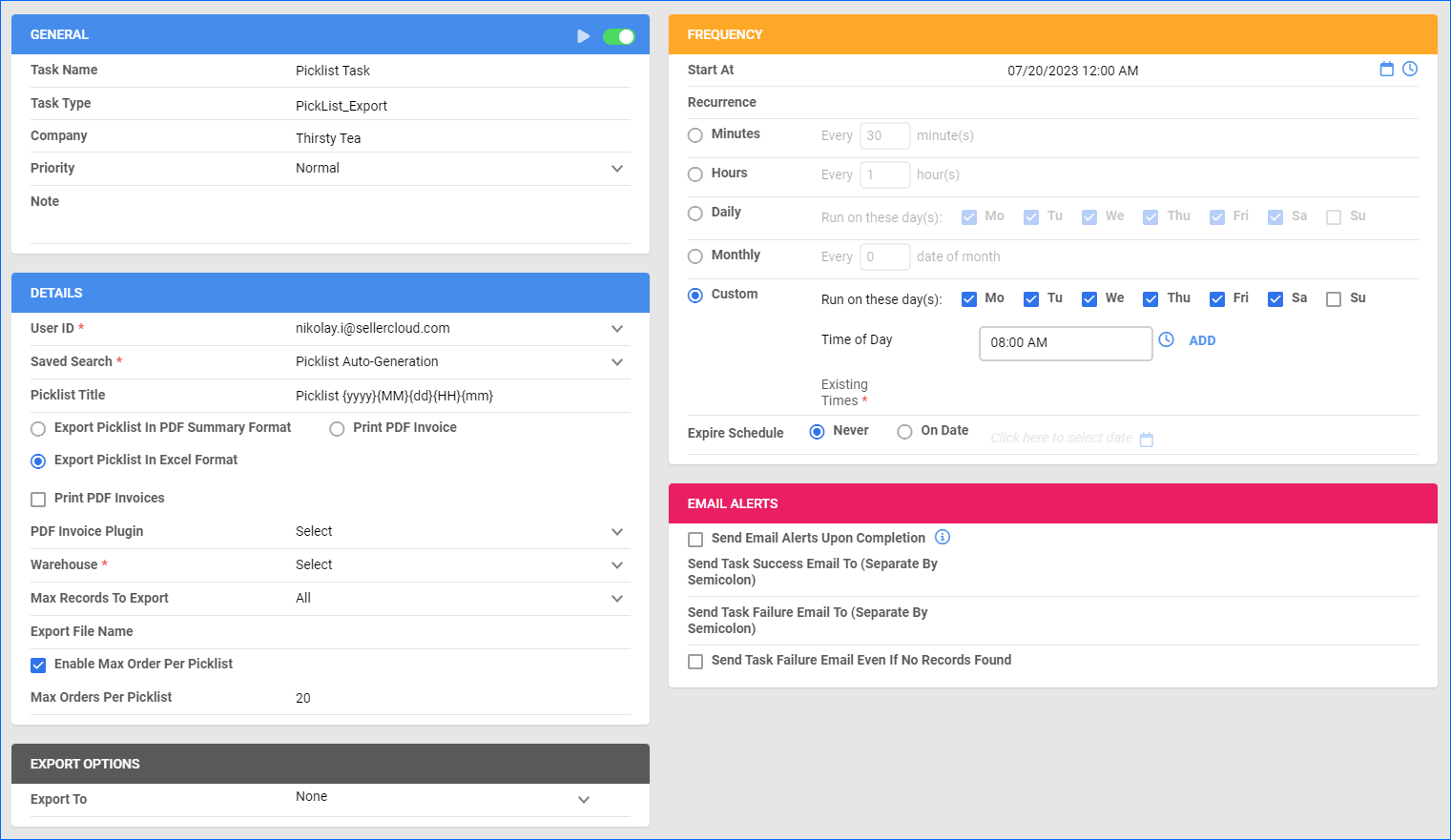Overview
Picklists can increase efficiency by generating a summarized list of product quantities needed to fill selected orders. Picklists can be also printed as a PDF document or exported to Excel and given to the shipping department for accurate picking, packing, and shipping. In this article, you will learn how to generate, manage, and filter picklists in Sellercloud. You will also learn how to filter Shipbridge based on assigned split picklists.
In Sellercloud, picklists can be generated based on warehouse, meaning that the inventory and pick quantity displayed will be based on the inventory and pick quantity available at the specified warehouse. This is controlled in Client Settings by checking Enable Pick List Generation by Warehouse.
Orders with shadow products will have parent products in the picklist. Similarly, kit products will have their child components in the picklist.
Generate Picklists
With Sellercloud, you can generate picklists manually or automatically.
Manually
To generate picklists manually:
- Go to Orders > Manage Orders > Select orders.
- Click on Action menu > Generate Pick List.

- Title your Picklist. Choose a Warehouse.

Automatically
For this purpose, you need:
- A Saved View for Orders
- A Scheduled Task of the PickList Generate type
To create the Saved View:
- Go to Orders > Manage Orders.
- Add the following filters:
- Order Date Range = Preferred date range, usually Last 120 days
- Shipping Status = Unshipped
- Order Status = Processing
- Dropship Status = Dropship None
- Payment Status = Charged (If the picklist does not include wholesale orders)
- Ship From Warehouse = One specific warehouse, to have a unique picklist per warehouse
- Is On Picklist = Not In Open Picklist or No (Optional, add it if you use the Close all picklists at midnight setting – check for more information below)
- Picked = None or Partially Picked (If you use Skustack)
- Single Item Orders = Single Item Orders or Multi Item Orders (For separate picklists for single-item and multi-item orders. See Picking Order Items for more information)
- Click the arrow icon next to Save View and select Save view as…
- Name it and click Save.
To close all picklists every night and create new ones in the morning that include any unshipped orders, enable the Client Setting Close All Picklists At Midnight and then set the Is On Picklist filter to Not In Open Picklist.
You can always add more filters to separate your picklists by channel, product group, and so on, but the filters listed above are essential.
Next, to create the Scheduled Task:
- Go to Settings.
- Select Scheduled Tasks > Manage Scheduled Tasks.
- Click the Create New Scheduled Task + button on the bottom right, and:
- Set the Task Type to PickList Generate.
- Enter a Task Name.
- Select the Company.
- Set the Start Time.
- Click Create.
- The following message appears at the bottom of your screen: “Scheduled task created successfully. Click Here to configure the task details.” – click the link.
- Click the Edit button on the top right.
- In the Details section:
- Click the User ID menu and select your ID.
- Click the Saved Search menu and select the saved search you created earlier.
- Set the Picklist Title as you prefer. You can use the following placeholder {yyyy}{MM}{dd}{HH}{mm} to populate the name with the picklist creation date.
- Optionally, choose if you want to Export Picklist In PDF Summary Format, Print PDF Invoice, or Export Picklist In Excel Format.
- Select the Warehouse.
- Optionally, check Enable Max Order Per Picklist and set the number of Max Orders Per Picklist. This way, the task creates a picklist with child picklists based on the specified limit. Without this option, a default value will be loaded from the Client Setting Default Max. Number of Orders/Shipper.
- This task will create picklists on the Manage Picklists page regardless of the Export To option, but you can also export the picklist in PDF or Excel to one or more email addresses or to an FTP.
- In the Frequency section, specify when the task will run.
- In the General section, click the Enable button.
- Click Save on the top right.
Manage Picklists
To manage picklists:
- To access picklists: Go to Orders > Manage Picklists.
- To close picklists: Select them > Click on the Action menu > Close picklists.
- To export a picklist: Open your picklist > Click on Actions > Select an option.

- To split picklists: When dealing with a high volume of orders, trying to load all the orders across every shipping station risks a system overload. To mitigate this risk you can split your picklists by number of orders per shipper.
- You can also Divide Picklist Between Pickers from the Action Menu.
Picklist Columns and Filters
Picklists will generate with the following default columns:
- SKU — An item’s unique identification number.
- Item — Name of the product.
- Qty — Quantity of units to pick to fill selected orders.
- Location — Location of the item in the warehouse (if set on the product’s Home page).
- Package — Shipping package type (if set on the product’s Shipping Preference page).
- Inventory — The available quantity you have on hand to pick: Aggregate + Unshipped = Inventory. This is not necessarily the total physical quantity.
- UPC — The item’s barcode.
Additional columns can be enabled from Client Settings:
- Replacement SKU
- Replacement SKU LOC
- Weight
The following filters can be used to filter SKUs and quantities on the picklist:
| Filter | Description |
| Has Available Inventory |
|
| Available in Warehouse of Picklist | This filter checks the Aggregate (sellable) quantity of the SKUs, and their shadows, within the warehouse specified on the Picklist.
|
| SKU Exists |
|
| Single Item Order |
|
| Rush Order |
|
| Is Kit |
|
| Is Picked |
|
Note: Instead of generating a picklist of all orders and then using the picklist filters, it may be more efficient to filter the orders first. For example, you may want to use the Back Order filter to filter out orders with items that are out of stock. To include orders like this in your picklist, go to Client Settings and check the box marked Consider ReplacementSKU Qty in BackOrder Calculation.
Use Picklists in Shipbridge
Shippers can now filter their Shipbridge based on their assigned split picklist. This allows different orders to be streamed to different stations, which keeps the system from overloading and prevents double shipping.
To generate a picklist in Shipbridge:
- Load Orders.
- Check the boxes to the left of orders to select them.
- Click Menu and select Generate Pick List.

- Check or uncheck the boxes to select what you want to print.
- Select Export to Excel to download the picklist as a .csv file.
- Select Print List to print out the picklist.

To use Sellercloud picklists to prevent double shipping orders in Shipbridge:
- Click Menu > Options and then select the Shipping tab.
- Enable Only allow shipping of orders loaded from picklists.
- Enter the picklist ID in the Picklist # filter. You may need to enable the filter under Menu > Customize Interface > Filters.
- Select the items in the picklist and press Load Selected.
- Press OK to load orders.
Overview
Picklists can increase efficiency by generating a summarized list of product quantities needed to fill selected orders. Picklists can be printed to a PDF document or exported to Excel and given to the shipping department for accurate picking, packing, and shipping. Picklists can be generated based on warehouse, meaning that the inventory and pick qty displayed will be based on inventory in a specified warehouse. This is controlled by client setting Enable Pick List Generation by Warehouse.
Generate a Picklist
- From the Manage Orders page select desired orders. Use the filters to generate picklists efficiently. See the example below.
- Select Generate Picklist from the Action Menu and press GO.
- Select a warehouse when picklist generation by warehouse is enabled. See above.
- The Picklist will enter a job queue. (This action can also be done from an order detail page.)
- Navigate to the picklist by clicking on the displayed job link or by clicking the Manage Picklists button to find and manage your picklists.
- View the picklist by clicking on the Show Picklist hyperlink.
- See below the explanation of picklists.
- Export to a PDF or Excel from the action menu. Export options include picklists with product images.
Picklists
Orders with shadow products will have the parent products in the picklist. Similarly, kit products will have their child components in the picklist. Picklists will generate with the following default columns:
- SKU
- Product Name
- Qty – Quantity of units to pick to fill selected orders.
- Location – Location of item in Warehouse (if set on the product home page)
- Package – Shipping package type (if set on the product’s Shipping Preference page.)
- Inventory – The available quantity you have on hand to pick: Aggregate + Unshipped = Inventory. This is not necessarily the total physical qty.
- UPC
Additional columns can be enabled from the client settings:
- Purchaser
- Replacements
- Replacement SKU
- Replacement SKU LOC
- Weight
The following filters can be used to filter SKUs and quantities on the picklist.
- Inventory: As noted above – Aggregate + Unshipped = Inventory
- All – will display all items regardless if there is inventory to fill the orders.
- Available – filters to display products and pick quantity that can fill orders completely. For example, if “Item A” has a quantity of 5 and the picklist has 1 order for 6 units of that product, “Item A” will not display when the “Available” filter has been selected. If there are 2 orders for 3 units (2 x 3 = 6) then “Item A” will display in the grid with a pick quantity of 3 only, because there isn’t enough quantity to fill the 2nd order. Older orders will take precedence over newer orders.
- Not Available – filters to display products and pick qty. without enough inventory to fill the orders. For example, if “Item A” has a quantity of 5 and the picklist has an 1 order for 6 units of that product, “Item A” will display when the “Not Available” filter has been selected. If there are 2 orders then “Item A” will display in the grid with a pick quantity of the unfillable quantity. Older orders will take precedence over newer orders.
- SKU
- All – Known and Unknown SKUs
- Known – filters to display only products that have a ProductID in SellerCloud.
- Unknown – filters to display SKUs that don’t have a corresponding Product record. This can happen if orders are imported from somewhere for products that SellerCloud isn’t aware of.
- Items
- All – displays both single and multi item orders.
- Single Item – filters products that are in single item orders – one unit of one SKU. Read more here.
- Multi Item – filters products that are in Multi Item orders – more than one unit of the same SKU or multiple skus in one order. Read more here. Please note that kit items are Multi Item orders and can be affected by the “Kit Items” filter
- Kit Items
- All – displays both kit and not kit items
- Kit Items – displays only kit items. Please note that kit items are Multi Item orders and can be affected by the “Items” filter
- Not Kit Items – displays only non-kit items.
Generate Filtered Picklists
Instead of generating picklist of all orders and then using the picklist filters, it may be more efficient to filter the orders before generating a picklist. For example, use the “Back Order” filter to filter out orders with items not in stock. (Enable client setting Consider ReplacementSKU Qty in BackOrder Calculation to include such orders in the picklist.) There is an action to Confirm related orders since ShipBridge can be set to only allow confirmed orders to ship. Using the confirmed status, together with these filters, it is possible to make sure that the shipper doesn’t see any orders that are Unknown or Not Available.
To generate a picklist in Shipbridge:
- Load Orders.
- Check the boxes to the left of orders to select them.
- Click Menu and select Generate Pick List.

- Check or uncheck the boxes to select what you want to print.
- Select Export to Excel to download the picklist as a .csv file.
- Select Print List to print out the picklist.

Picklists can be used to prevent double-shipping orders in ShipBridge.
- In ShipBridge, navigate Menu > Options > Shipping Tab. Enable setting Only allow shipping of orders loaded from picklists.
- Generate a picklist for orders in SellerCloud.
- In ShipBridge, Enter the picklist ID in the picklist filter. You may need to enable the filter under Menu > Customize Interface > Filters tab.
- Select the items in the picklist and press Load Selected.
- Press OK to load orders.




